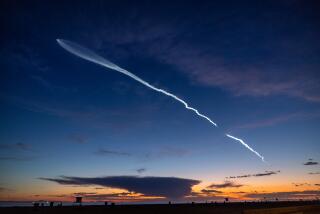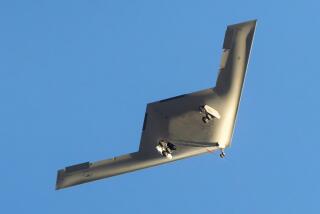Air Force set to blast off another secretive space drone
An experimental robotic space plane developed for the Air Force is slated to launch Tuesday from Cape Canaveral, fueling an ongoing mystery about its hush-hush payload and overall mission.
Air Force officials offered few details about the mission. They say the unmanned space plane, which resembles a miniature version of the space shuttle, simply provides a way to test new technologies in space, such as satellite sensors and other components.
But this is the third time that the Air Force will send an X-37B Orbital Test Vehicle into orbit. Launch is planned for 10:03 a.m. PDT.
PHOTOS: X-37B Orbital Test Vehicle
The first X-37B was launched in April 2010 and landed 224 days later on a 15,000-foot airstrip at Vandenberg Air Force Base, northwest of Santa Barbara. The second X-37B spent 469 days in space.
The only information the government released was when the space plane was launched and when it returned.
Because of its clandestine nature, some industry analysts have theorized it could be a precursor to an orbiting weapon, capable of dropping bombs or disabling foreign satellites as it circles the globe.
But the Pentagon has repeatedly said the X-37B is simply a “test bed” for other technologies.
PHOTOS: X-37B Orbital Test Vehicle
The X-37B is about 29 feet long, or about the size of a small school bus, with stubby wings that stretch out about 15 feet tip to tip. It is one-fifth the size of the space shuttle and can draw on the sun for electricity using unfolding solar panels. It is designed to stay in orbit for 270 days.
The spacecraft was built in tight secrecy by Boeing Co.’s Space and Intelligence Systems unit in Huntington Beach. Engineering work was done at the company’s facilities in Huntington Beach and Seal Beach. Other components were supplied by its satellite-making plant in El Segundo.
Weather permitting, the plane is set to be launched Friday atop a 19-story Atlas V rocket, which will lift the spacecraft into orbit inside the nose cone. Once in orbit, the X-37B will emerge for its estimated nine-month journey.
ALSO:
SpaceX to launch military satellites in 2014, 2015
Black Hawk helicopter flies itself over mountain range in test
Navy catapults experimental bat-winged drone into flight [Video]
More to Read
Sign up for Essential California
The most important California stories and recommendations in your inbox every morning.
You may occasionally receive promotional content from the Los Angeles Times.











